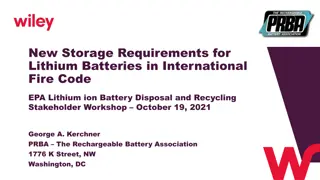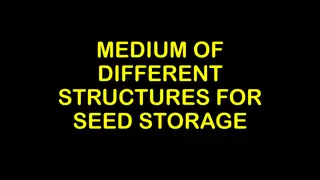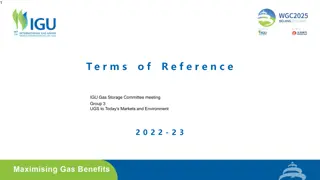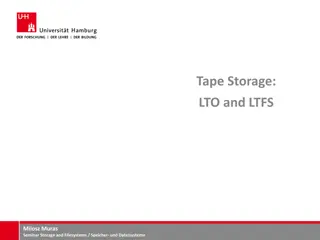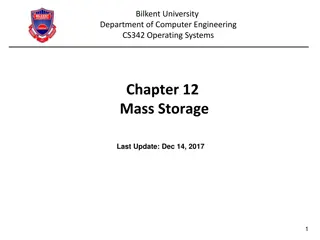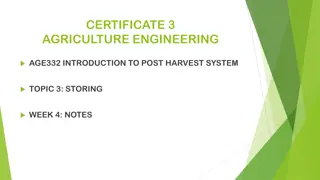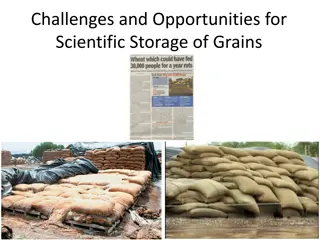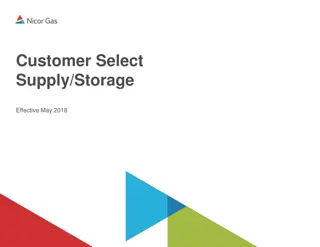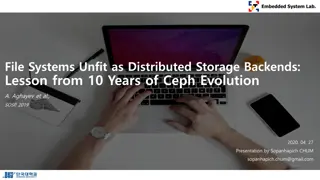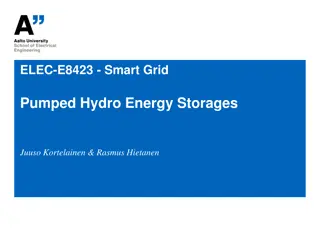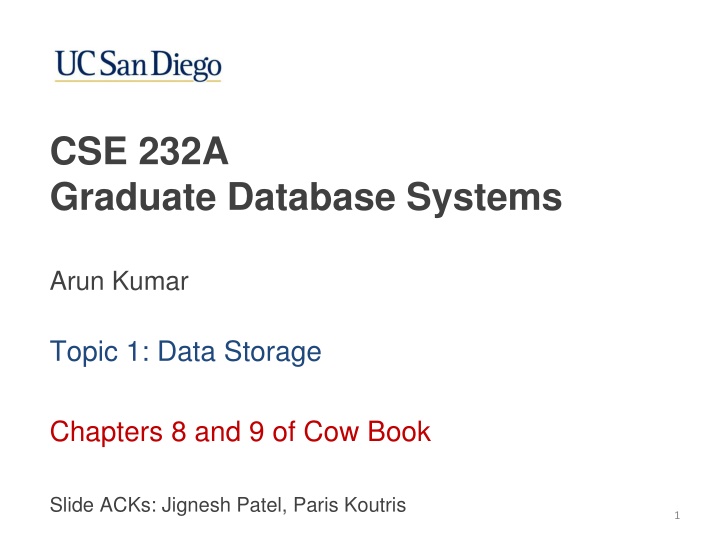
Database Systems Data Storage and Management Overview
Explore the lifecycle of an SQL query, RDBMS architecture, storage management subsystems, disk components, and the functioning of storage devices like disks. Learn about data storage organization, memory hierarchy, and how disks work in database systems.
Uploaded on | 0 Views
Download Presentation

Please find below an Image/Link to download the presentation.
The content on the website is provided AS IS for your information and personal use only. It may not be sold, licensed, or shared on other websites without obtaining consent from the author. If you encounter any issues during the download, it is possible that the publisher has removed the file from their server.
You are allowed to download the files provided on this website for personal or commercial use, subject to the condition that they are used lawfully. All files are the property of their respective owners.
The content on the website is provided AS IS for your information and personal use only. It may not be sold, licensed, or shared on other websites without obtaining consent from the author.
E N D
Presentation Transcript
CSE 232A Graduate Database Systems Arun Kumar Topic 1: Data Storage Chapters 8 and 9 of Cow Book Slide ACKs: Jignesh Patel, Paris Koutris 1
Lifecycle of an SQL Query Query Result Query Database Server Query Scheduler Execute Operators Parser Optimizer | | | ..| ..| | | | ..| ..| | | | ..| ..| | | | ..| ..| | | | ..| ..| | | | ..| ..| | | | ..| ..| | | | ..| ..| | | | ..| ..| | | | ..| ..| | | | ..| ..| Query Result Select R.text from Report R, Weather W where W.image.rain() and W.city = R.city and W.date = R.date and R.text. matches( insurance claims ) Query Syntax Tree Query Plan Segments 2
RDBMS Architecture Storage Management Subsystem 3
Another View of Storage Manager Access Methods Recovery Manager Control Manager Concurrency Sorted File Hash Index B+-tree Index Heap File Buffer Manager I/O Manager I/O Accesses 4
Outline Data Storage (Disks) Memory Management File Organization Emerging Hardware: SSDs and NVMs (Optional) Buffer Replacement Policies 5
Storage/Memory Hierarchy CPU Cache Main Memory Non-Volatile Memory? Flash Storage Magnetic Hard Disk Drive (HDD) 6 Tape
Disks Widely used secondary storage device Data storage/retrieval units: disk blocks or pages Unlike RAM, different disk pages have different retrieval times based on location! Need to optimize layout of data on disk pages Orders of magnitude performance gaps possible! 7
Components of a Disk 1 block = n contiguous sectors (n fixed during disk configuration) 9
How does a Disk Work? Magnetic changes on platters to store bits Spindle rotates platters 7200 to 15000 RPM (Rotations Per Minute) Head reads/writes track Exactly 1 head can read/write at a time Arm moves radially to position head on track 10
How is the Disk Integrated? OS interfaces with the Disk Controller 11
Disk Access Times Rotational delay Waiting for sector to come under disk head Function of RPM; typically, 0-10ms (avg v worst) Seek time Moving disk head to correct track Typically, 1-20ms (high-end disks: avg is 4ms) Transfer time Moving data from/to disk surface Typically, hundreds of MB/s! 12
Typical Modern Disk Spec Capacity RPM Transfer #Platters Avg Seek Price 13
Data Organization on Disk Disk space is organized into files (a relation is a file!) Files are made up of disk pages aka blocks Typical disk block/page size: 4KB or 8KB Basic unit of reads/writes for a disk OS/RAM page is not the same as disk page! Typically, OS page size = disk page size but not necessarily; it could be a multiple, e.g., 1MB Pages contain records (tuples) File data (de-)allocated in increments of disk pages 14
Disk Data Layout Principles Sequential access v Random access Reading contiguous blocks together amortizes seek time and rotational delay! For a transfer rate of 200MB/s, sequential reads can be ~200MB/s, but random reads ~0.3MB/s Better to lay out pages of a file contiguously on disk Next block concept: On same track (in rotation order), then same cylinder, and then adjacent cylinder! 15
Is it possible to exploit RAM better and avoid going to disk all the time? 16
Outline Data Storage (Disks) Memory Management File Organization Emerging Hardware: SSDs and NVMs (Optional) Buffer Replacement Policies 17
Buffer Management Pages should be in RAM for DBMS query processing But not all pages of a database might fit in RAM! Buffer Pool A part of main memory that DBMS manages Divided into buffer frames (slots for pages) Buffer Manager Subsystem of DBMS to read pages from disk to buffer pool and write dirty pages back to disk 18
Buffer Management Buffer Pool Page in an occupied frame Free frames RAM Disk Buffer Replacement Policy decides which frame to evict DB 19
Page Requests to Buffer Manager Request a page for query processing (read or write) Release a page when no longer needed Notify if a page is modified (a write op happened) 20
Buffer Managers Bookkeeping 2 variables per buffer frame maintained Pin Count Current number of users of the page in the frame Pinning means PinCount++; page requested Unpinning means PinCount is 0; page released Dirty Bit Set when a user notifies that page was modified Must write this page back to disk in due course! Q: What if 2 users pin and modify the same page?! 21
Handling Page Requests Choose a frame for replacement(buffer replacement policy); it should have Pin Count 0! If chosen frame has Dirty Bit set, flush it to disk Read requested page from disk into chosen frame Pin the page and return the frame address No Is page in buffer pool? Yes Return address of the frame in the pool Increment Pin Count 22
Buffer Replacement Policy Policy to pick the frame for replacement Has a major impact on I/O cost (number of disk I/Os) of a query based on its data access pattern Popular policies: Least Recently Used (LRU) Most Recently Used (MRU) Clock (LRU variant with lower overhead) First In First Out (FIFO), Random, etc. 23
DBMS vs OS Filesystem Q: DBMS sits on top of OS filesystem; so, why not just let OS handle database file layout and buffer management? DBMS knows fine-grained information of data access patterns of this application compared to OS! Can pre-fetch pages as per query semantics Can better interleave I/Os and computations Can exploit multiple disks more effectively (RAID) Own buffer pool lets DBMS adjust buffer replacement policy, pin pages to memory, and flush dirty pages 24
Outline Data Storage (Disks) Memory Management File Organization Emerging Hardware: SSDs and NVMs (Optional) Buffer Replacement Policies 25
Data Organization Basics: Recap Disk space is organized into files (a relation is a file!) Files are made up of pages File data (de-)allocated in increments of disk pages Pages contain records (tuples) Higher levels operate on (sets of) records! How pages are organized in a file: Page Layout How records are organized in a page: Record Layout 26
Unordered (Heap) Files Simplest structure; records/pages in no particular order Pages added/deleted table grows/shrinks Metadata tracked to enable record-level access: Pages in the file (PageID) Records in a page (RecordID) Free space in a page Operations on the file: insert/delete file, read a record with a given RID, scan records (maybe with predicate), add/delete record(s) 27
Heap File as Linked Lists Data Page Data Page Data Page Full Pages Header Page Data Page Data Page Data Page Pages with Free Space (Filename, Header PageID) stored in known catalog Each page has 2 pointers (PageIDs) and data records Pages in second list have some free space Q: Why would free space arise in pages? 28
Heap File as Page Directory Data Page 1 Header Page Data Page 2 Data Page N Directory Entry in directory for each page: Is it free or full? How many bytes of free space? Faster to identify page with free space to add records 29
Data Organization Basics: Recap Disk space is organized into files (a relation is a file!) Files are made up of pages File data (de-)allocated in increments of disk pages Pages contain records (tuples) Higher levels operate on (sets of) records! How pages are organized in a file: Page Layout How records are organized in a page: Record Layout 30
Record Layout Desiderata Higher levels (queries) operate on sets of records Records are stored in slotted pages Page is a collection of slots; one record per slot Physically, RecordID = <PageID, SlotNumber>! Many record layouts possible Need to support record-level operations efficiently Insert a record or multiple records Read/update/delete a record given its RecordID Scan all records (possibly applying a predicate) 31
Record Layout and Format Outline Layout of fixed-length records: Packed layout Unpacked layout Layout of variable-length records Record format for fixed-length records Record formats for variable-length records Delimiter-based Pointer-based 32
Layout of Fixed-length Records Slot 1 Slot 2 Slot 1 Slot 2 . . . . . . Free Space Slot N Slot N Number of slots Slot M N . . . 1 1 1 M 0 Number of records Bitmap M ... 3 2 1 Unpacked Packed Recall that RecordID = <PageID, SlotNumber> Con for Packed: moving/deleting records alter RecIDs Con for Unpacked: extra space used by bitmap 33
Layout of Variable-length Records Start Page num = 11 Rid=? Rid= (11, 1) 120, 40 5 -1, 0 4 560, 90 3 -1, 0 2 0, 70 1 70, 50 0 6 Book-keeping Dir. grows backwards! Free Space Pointer Slot directory Slot num Slot entry: offset, length 34
Layout of Variable-length Records Pros: moving records on page does not alter RID! Good for fixed-length records too Deleting a record: offset is set to -1 Inserting a new record: Any available slot can be used (incl. in free space) If not enough free space, reorganize 35
Fixed-length Record Format All records in a file are same type and length System catalog contains attribute data type lengths F1 F2 F3 F4 L1 L2 L3 L4 Base address (B) Address = B+L1+L2 36
Variable-length Record Formats F1 F2 F3 F4 Delimiter symbol Field Count 4 $ $ $ $ Array of Integer Offsets Both store fields consecutively; count fixed by schema! Con of delimiter-based: need to scan record from start to retrieve even a single field (attribute) Cons of pointer-based: small dir. overhead; growing records require maintaining dir.; records larger than a page! 37
Column Store Layout Consider the following SQL query: Movies (M) MovieID Name Year Director SELECT COUNT(DISTINCT Year) FROM Movies M Q: Why bother reading other attributes? Often, analytical queries read only one or a few attributes; reading other attributes wastes I/O time! Column store DBMSs lay out relations in column- major order to help speed up such queries 38
Column Store Layout MovieID 20 16 53 74 Name Inception Avatar Gravity Blue Jasmine 2013 Year 2010 Christopher Nolan 2009 Jim Cameron 2013 Alfonso Cuaron Woody Allen Director Pages in a column store layout: 20, 16, 53, 74 Inception, Avatar Gravity, Blue Jasmine High potential for data compression! 2010, 2009, 2013, 2013 Q:When is column store bad for performance? 39
Recap Data Storage (Disks) Storage hierarchy Disk architecture and access times Memory Management Buffer pool and frames for pages Handling page requests File Organization Page layouts (heap files) Record layouts (fixed, variable, columnar) 40
Outline Data Storage (Disks) Memory Management File Organization Emerging Hardware: SSDs and NVMs (Optional) Buffer Replacement Policies 41
Storage/Memory Hierarchy CPU Cache Main Memory Non-Volatile Memory? Flash Storage Magnetic Hard Disk Drive (HDD) 42 Tape
Flash Solid State Drive vs Hard Disks Roughly speaking, flash combines the speed benefits of RAM with persistence of disks Random reads/writes are not much worse Locality of reference different for data/file layout But still block-addressable like HDDs Data access latency: 100x faster! Data transfer throughout: Also 10-100x higher Parallel read/writes more feasible Cost per GB is 5-15x higher! Read-write impact asymmetry; much lower lifetimes 43
Flash SSDs in RDBMSs Q: How best to exploit flash SSDS for RDBMSs? Various ideas explored in research: Fully replace hard disks Supplement HDDs; but to store which part of DB? Just the logs of transactions Index structures Hot relations/data structures Requires rethinking DBMS techniques! No consensus yet; fully replace becoming common 44
Ongoing Research: SSD+RDBMS IEEE Data Engineering Bulletin 2010 ACM SIGMOD 2011 45
NVMs vs Disks Roughly speaking, NVMs are like persistent RAM, but with similar capacity as SSDs Random R/W with less to no SSD-style wear and tear Byte-addressability (not blocks like SSDs/HDDs) Locality of reference concept radically changes Latency, throughput, parallelism, etc. similar to RAM Yet to see light of day in production settings Cost per GB: No one knows yet. :) (Switch to Andy s slides on NVMs for RDBMSs) 46
Least Recently Used (LRU) Queue of pointers to frames with PinCount of 0 Add newly unpinned frame to end of queue For replacement, grab frame from front of queue Example: 5 pages on disk: A, B, C, D, E 3 frames in pool Page request sequence: Request A, Request B, Modify A, Request D, Release B, Release A, Request E, Request C, Release C, Release D, Release E 48
Least Recently Used (LRU) Buf. Pool Release B Release A Page PC DB A B D 1 0 1 1 0 0 - 0 0 0 0 0 0 - - A B D 0 0 1 1 0 0 and so on Release C Request A Request D Request E A 1 0 0 0 0 0 Request B - - A B D 1 1 1 1 0 0 C E D 0 1 1 0 0 0 A E D 0 1 1 1 0 0 Request C Flush A! Modify A A B 1 1 0 0 0 0 - A B 1 1 0 1 0 0 - C E D 1 1 1 0 0 0 F0 Queue of pointers: F1 49
Clock Algorithm Variant of LRU with lower overhead (no queue) N buffer frames treated logicallyas a circle: the clock Currentvariable points to a frame: the hand Each frame has Referenced Bit (along with PC, DB) Finding a frame to replace: If PC > 0, increment Current If PC == 0 : If RB == 1, set its RB = 0 and increment Current If RB == 0, pick this frame! 50





